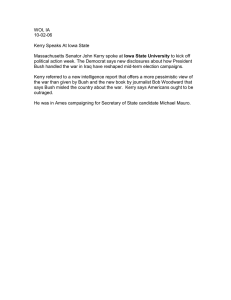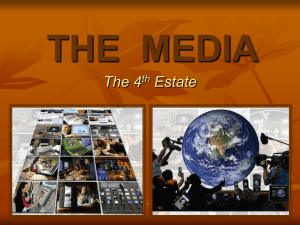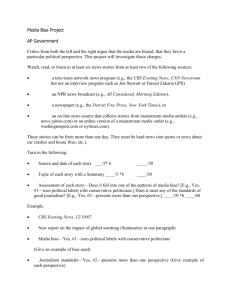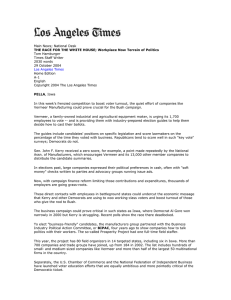American Government Mass Media
advertisement
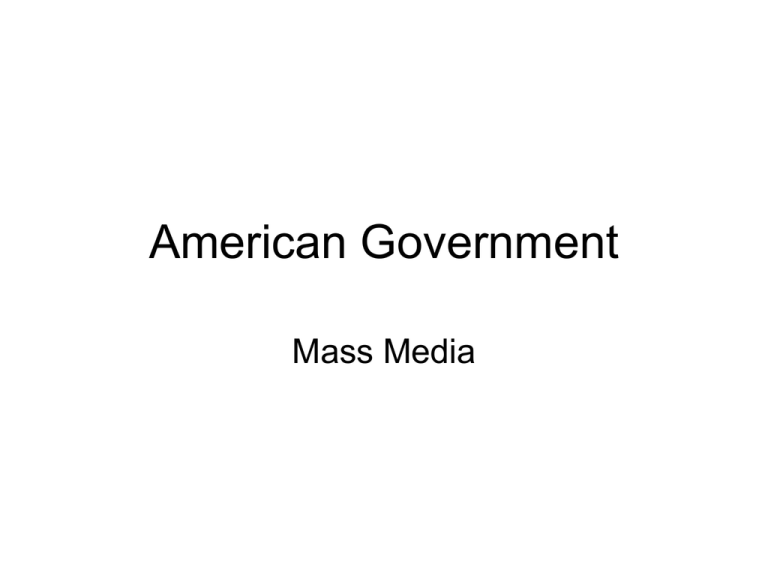
American Government Mass Media What Gets Covered in the News? • Reflects the fact that news media is profitdriven – Goal: maximize sales, minimize costs – Trend from local and independent to national/international conglomerates Media Consolidation • 1983 – 50 corporations dominate • 1990 – 23 corporations dominate • 2000 – 6 corporations dominate • 1946: 75% of daily newspapers are family owned • 2000: 2% of daily newspapers are family owned Causes of Conglomeration • Economic Incentives – Synergy • Changes in Regulation – Cross ownership rules Four News Biases • Personalization • Dramatization • Fragmentation • Authority-Disorder Bias Personalization • The news deemphasizes big social and economic problems in favor of human trials, tragedies and triumphs – Causes an egocentric view of political problems – Encourages a passive spectator attitude Dramatization • The news tells stories as a dramatic narrative; often lacking analysis – Trivializes news content – Draws focus to only extreme examples – Ignores problems until they are big Fragmentation • The news isolates stories from each other and from their natural contexts – Makes it difficult to attribute cause and effect – Isolates individual actors from context Authority-Disorder Bias • The news highlights authoritative voices of public officials to create both fear and reassurance – Emphasizes “pseudo-events” with “return to normal” or “to be continued” endings How the Media Covers Politics • Focus on the president Proportion of time spent covering the President, Congress, and the Supreme Court on the network TV news (during the early 1990s): President 60% Congress 37% Supreme Court 3% – President single person, cheap – Congress and executive branch agencies large – Courts expensive, not public News Coverage of Elections • Little coverage of issue positions – Belief that people tune out – Proposals not timely or novel • Focus on candidates’ personal qualities • Focus on the “horse race” and strategy – Candidates criticize each other (dramatic) – “Horse race” both timely and novel Some Headlines from 2004 Election • • • • • • Bush Using Convention to Woo Undecideds Kerry Gets Little Bounce from Veep Choice Two New Bush Ads Assail Kerry on Health Care Bush, Kerry Spar Over Bin Laden Video Bush, Kerry Hope to Win Voters in Debates New Poll Shows Kerry Nearly Even with Bush Has the News Media Perceived its Audience Correctly? • Evidence suggesting yes: – Low ratings of News Hour with Jim Lehrer – Cable news ratings increase with dramatic events – Stories Americans pay attention to (see next slide) Stories Americans Tuned in 19861999 Percentage of Americans who followed the story “very closely” Explosion of the space shuttle Challenger 80% San Francisco earthquake 73% Los Angeles riots 70% Columbine shootings 68% Explosion during Atlanta Olympics 57% Death of Princess Diana 54% 1996 New Hampshire Republican primary 22% Congressional debate about NAFTA 21% Robert Bork’s nomination to the Supreme Court 17% Passage of the communications deregulation bill 12% Debate on expanding NATO into Eastern Europe 5% Has the News Media Perceived its Audience Correctly? • Evidence suggesting no: – Questions citizens ask of candidates (ex: YouTube Debates!) – What Americans say they want from election coverage (see next slide) What Americans Say They Want from Election Coverage Candidates’ stands on issues How election affects people like you Third party and independent candidates Campaign strategies and tactics Which candidates are ahead Personal lives of candidates Very Media devotes too much 77% 72% 27% 26% 22% 14% 8% 11% 10% 33% 46% 68% interested attention In Covering Politics, Does the News Media Tilt in a Liberal or Conservative Direction? • Rate the following news organizations as liberal, conservative, or neutral: – Seattle Times – New York Times – Wall Street Journal – Fox News – National Public Radio – NBC Evening News Evidence of Liberal Bias • Among people who work for news organizations, Democrats outnumber Republicans Evidence of Liberal Bias • Compared to the public, the press is much less conservative Evidence of Liberal Bias • The public perceives the media to be biased Evidence of Conservative Bias • News media is a profit-seeking business – Owners of media conglomerates are largely conservative – Bias in favor of corporate interests – Leads to media self-censorship • Killing stories that undermine corporate interests • How could we determine if such bias exists? Implications • If we accept that most people who work for news organizations are moderate to liberal, is that problematic? • Does that mean they will be biased in their coverage? • Or can they separate their own beliefs from their reporting duties?
